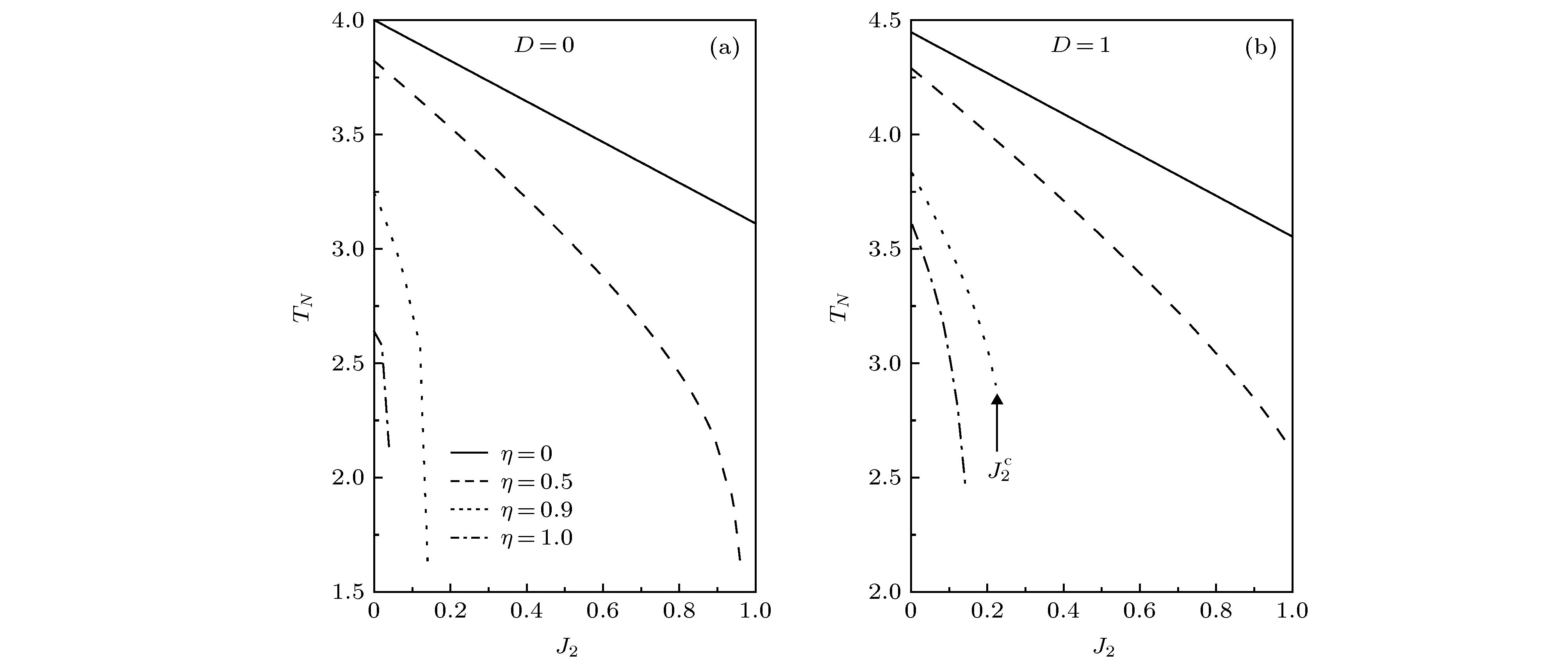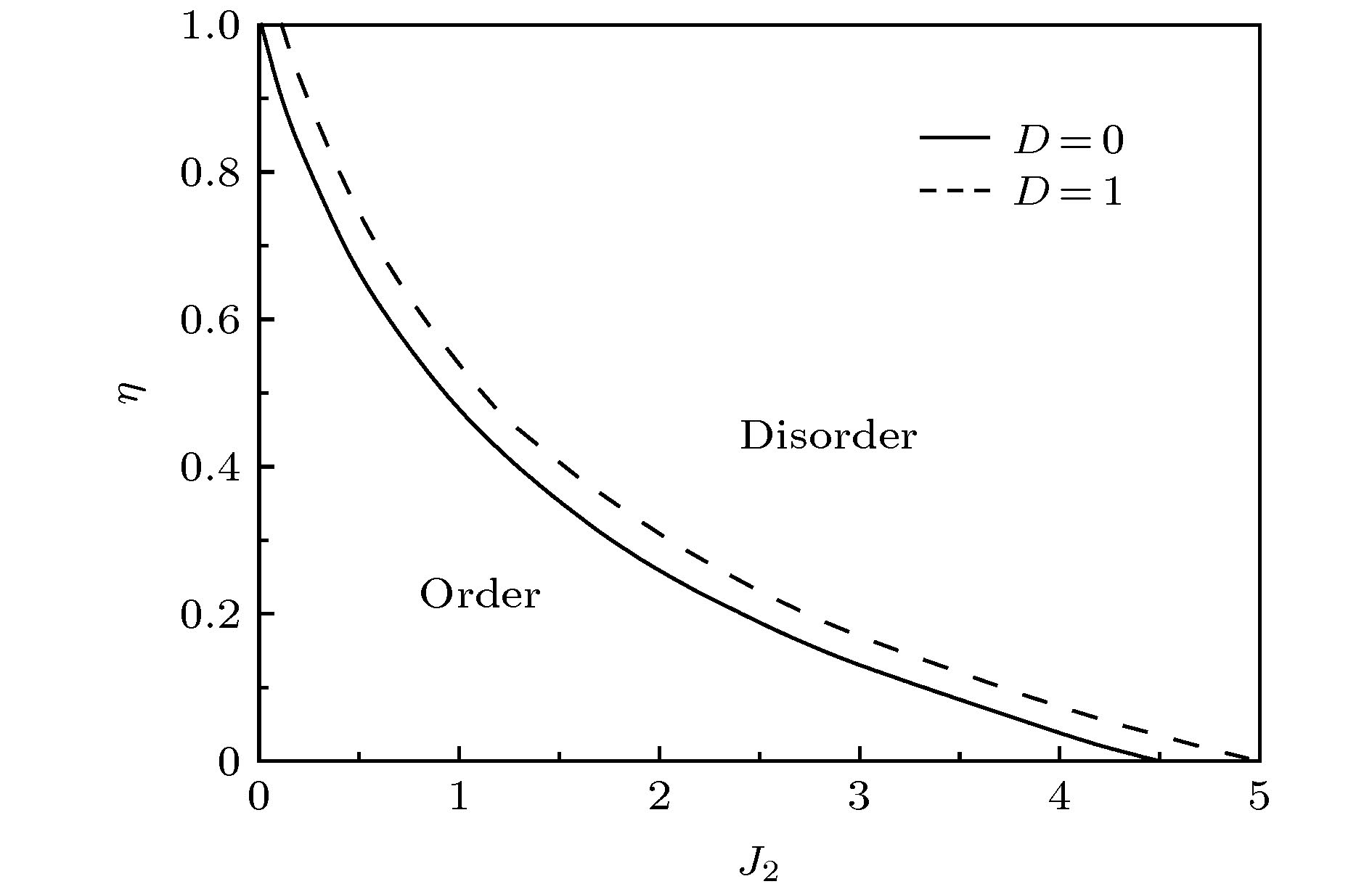-
The existence of biquadratic exchange had been well established by Anderson, Huang and Allen. Early investigations indicated that the biquadratic exchange term in spin Hamiltonian was found to have significant effects on the magnetic properties of compounds containing iron-group ions or rare-earth metal ions. Recently, studying the anisotropic magnetic excitation of iron-based superconducting materials indicated that the experimental phenomenon cannot be explained well only by a simple collinear Heisenberg antiferromagnetic model. However, if the nearest neighbor biquadratic spin coupling is introduced, the experiment can be well explained. Similar results had also been obtained in the investigation of the superconducting material FeSe. As a result, exploring the effect of biquadratic exchange interactions on the magnetic properties of magnetic systems is significance. In this paper, we use the double-time Green's function method to study the properties of the spin-1 Heisenberg antiferromagnets with biquadratic exchange interactions and anisotropy on a three-dimensional lattice. We derive the equation of motion of the Green's function by a standard procedure. In the course of this, the higher order Green functions have to be decoupled. For the higher order Green functions of different lattice points, a Tyablikov or random phase approximation decoupling are used to decuple. For the higher order Green functions of the same lattice points, we adopt the Anderson-Callen decoupling to decouple. Based on the above procedures, the analytic expressions of the magnetization and critical temperature are obtained. The effects of biquadratic exchange interactions and anisotropy on the critical temperature are discussed in detailed. Our results show that the critical temperature increases with the increase of the anisotropy for a given biquadratic interaction. Regardless of the value of the anisotropy, the critical temperature always decreases with the increase of the biquadratic interaction. As the value of anisotropic parameter
$\eta = 0$ , there is an obvious linear relationship between the critical temperature and the biquadratic interaction. However, when the anisotropy of the system becomes weaker, there is no such linear relationship between them. By comparing similar ferromagnetic models, it is found that the results of this paper are significantly different from those of the ferromagnetic model. When the biquadratic interaction is equal to 0, our results agree with other theoretical results.-
Keywords:
- antiferromagnetic /
- magnetic anisotropy /
- general theory and models of magnetic ordering /
- exchange and superexchange interactions
[1] Anderson P W 1959 Phys. Rev. 115 2
 Google Scholar
Google Scholar
[2] Huang N L, Orbach R 1964 Phys. Rev. Lett. 12 275
[3] Allan G A T, Betts D D 1967 Proc. Phys. Soc. London 91 341
 Google Scholar
Google Scholar
[4] Joseph R I 1965 Phys. Rev. 138 1441
 Google Scholar
Google Scholar
[5] Millet P, Mila F, Zhang F C, Mambrini M, Van Oosten A B, Pashchenko V A, Sulpice A, Stepanov A 1999 Phys. Rev. Lett. 83 4176
 Google Scholar
Google Scholar
[6] Mila F, Zhang F C 2000 Eur. Phys. J. B 16 7
 Google Scholar
Google Scholar
[7] Luo C, Datta T, Yao D X 2016 Phys. Rev. B 93 235148
 Google Scholar
Google Scholar
[8] Wysocki A L, Belashchenko K D, Antropov V P 2011 Nat. Phys. 7 485
 Google Scholar
Google Scholar
[9] Ergueta P B, Nevidomskyy A H 2015 Phys. Rev. B 92 165102
 Google Scholar
Google Scholar
[10] Zhuo W Z, Qin M H, Dong S, Li X G, Liu J M 2016 Phys. Rev. B 93 094424
 Google Scholar
Google Scholar
[11] Yu R, Si Q M 2015 Phys. Rev. Lett. 115 116401
 Google Scholar
Google Scholar
[12] Köbler U, Mueller R M, Schnelle W, Fischer K 1998 J. Magn. Magn. Mater. 188 333
 Google Scholar
Google Scholar
[13] Köbler U, Hoser A, Kawakami M, Chatterji T, Rebizant J 1999 J. Magn. Magn. Mater. 205 343
 Google Scholar
Google Scholar
[14] Yu R, Nevidomskyy A H 2016 J. Phys. Condens. Matter 28 495702
 Google Scholar
Google Scholar
[15] Chen H H, Levy P M 1973 Phys. Rev. B 7 4267
 Google Scholar
Google Scholar
[16] Iwashita T, Uryu N 1976 Phys. Rev. B 14 3090
 Google Scholar
Google Scholar
[17] Oitmaa J, Hamer C J 2013 Phys. Rev. B 87 224431
 Google Scholar
Google Scholar
[18] Rabuffo I, De Cesare L, D’Auria A C, Mercaldo M T 2019 Eur. Phys. J. B 92 154
 Google Scholar
Google Scholar
[19] Chaddha G S, Sharma A 1999 J. Magn. Magn. Mater. 191 373
 Google Scholar
Google Scholar
[20] Stanek D, Sushkov O P, Uhrig G S 2011 Phys. Rev. B 84 064505
 Google Scholar
Google Scholar
[21] Wang H Y 2012 Green’s Function in Condensed Matter Physics (Beijing: Alpha Science International Ltd and Science Press) p348
[22] 王怀玉, 夏青 2007 56 5466
 Google Scholar
Google Scholar
Wang H Y, Xia Q 2007 Acta Phys. Sin. 56 5466
 Google Scholar
Google Scholar
[23] Callen H B 1963 Phys. Rev. 130 890
 Google Scholar
Google Scholar
[24] Pan K K 2009 Phys. Rev. B 79 134414
 Google Scholar
Google Scholar
[25] Gaunt D S, Guttman A J. 1974 Phase Transitions and Critical Phenomena (New York: Academic Press) p456
[26] Pan K K 2005 Phys. Rev B 71 134524
 Google Scholar
Google Scholar
-
图 1 当单粒子各向异性参数D取0和1时, 交换各向异性参数
$\eta $ 为0, 0.5, 0.9, 1下相变温度${T_N}$ 与双二次型交换作用${J_2}$ 之间的关系曲线Figure 1. Nèel temperature as a function of biquadratic exchange for the exchange anisotropic parameter
$\eta {\rm{ = 0, 0}}{\rm{.5, 0}}{\rm{.9, 1}}$ when the single-ion anisotropic parameter$D = {\rm{0}}$ and 1. -
[1] Anderson P W 1959 Phys. Rev. 115 2
 Google Scholar
Google Scholar
[2] Huang N L, Orbach R 1964 Phys. Rev. Lett. 12 275
[3] Allan G A T, Betts D D 1967 Proc. Phys. Soc. London 91 341
 Google Scholar
Google Scholar
[4] Joseph R I 1965 Phys. Rev. 138 1441
 Google Scholar
Google Scholar
[5] Millet P, Mila F, Zhang F C, Mambrini M, Van Oosten A B, Pashchenko V A, Sulpice A, Stepanov A 1999 Phys. Rev. Lett. 83 4176
 Google Scholar
Google Scholar
[6] Mila F, Zhang F C 2000 Eur. Phys. J. B 16 7
 Google Scholar
Google Scholar
[7] Luo C, Datta T, Yao D X 2016 Phys. Rev. B 93 235148
 Google Scholar
Google Scholar
[8] Wysocki A L, Belashchenko K D, Antropov V P 2011 Nat. Phys. 7 485
 Google Scholar
Google Scholar
[9] Ergueta P B, Nevidomskyy A H 2015 Phys. Rev. B 92 165102
 Google Scholar
Google Scholar
[10] Zhuo W Z, Qin M H, Dong S, Li X G, Liu J M 2016 Phys. Rev. B 93 094424
 Google Scholar
Google Scholar
[11] Yu R, Si Q M 2015 Phys. Rev. Lett. 115 116401
 Google Scholar
Google Scholar
[12] Köbler U, Mueller R M, Schnelle W, Fischer K 1998 J. Magn. Magn. Mater. 188 333
 Google Scholar
Google Scholar
[13] Köbler U, Hoser A, Kawakami M, Chatterji T, Rebizant J 1999 J. Magn. Magn. Mater. 205 343
 Google Scholar
Google Scholar
[14] Yu R, Nevidomskyy A H 2016 J. Phys. Condens. Matter 28 495702
 Google Scholar
Google Scholar
[15] Chen H H, Levy P M 1973 Phys. Rev. B 7 4267
 Google Scholar
Google Scholar
[16] Iwashita T, Uryu N 1976 Phys. Rev. B 14 3090
 Google Scholar
Google Scholar
[17] Oitmaa J, Hamer C J 2013 Phys. Rev. B 87 224431
 Google Scholar
Google Scholar
[18] Rabuffo I, De Cesare L, D’Auria A C, Mercaldo M T 2019 Eur. Phys. J. B 92 154
 Google Scholar
Google Scholar
[19] Chaddha G S, Sharma A 1999 J. Magn. Magn. Mater. 191 373
 Google Scholar
Google Scholar
[20] Stanek D, Sushkov O P, Uhrig G S 2011 Phys. Rev. B 84 064505
 Google Scholar
Google Scholar
[21] Wang H Y 2012 Green’s Function in Condensed Matter Physics (Beijing: Alpha Science International Ltd and Science Press) p348
[22] 王怀玉, 夏青 2007 56 5466
 Google Scholar
Google Scholar
Wang H Y, Xia Q 2007 Acta Phys. Sin. 56 5466
 Google Scholar
Google Scholar
[23] Callen H B 1963 Phys. Rev. 130 890
 Google Scholar
Google Scholar
[24] Pan K K 2009 Phys. Rev. B 79 134414
 Google Scholar
Google Scholar
[25] Gaunt D S, Guttman A J. 1974 Phase Transitions and Critical Phenomena (New York: Academic Press) p456
[26] Pan K K 2005 Phys. Rev B 71 134524
 Google Scholar
Google Scholar
Catalog
Metrics
- Abstract views: 8982
- PDF Downloads: 116
- Cited By: 0





















 DownLoad:
DownLoad:








